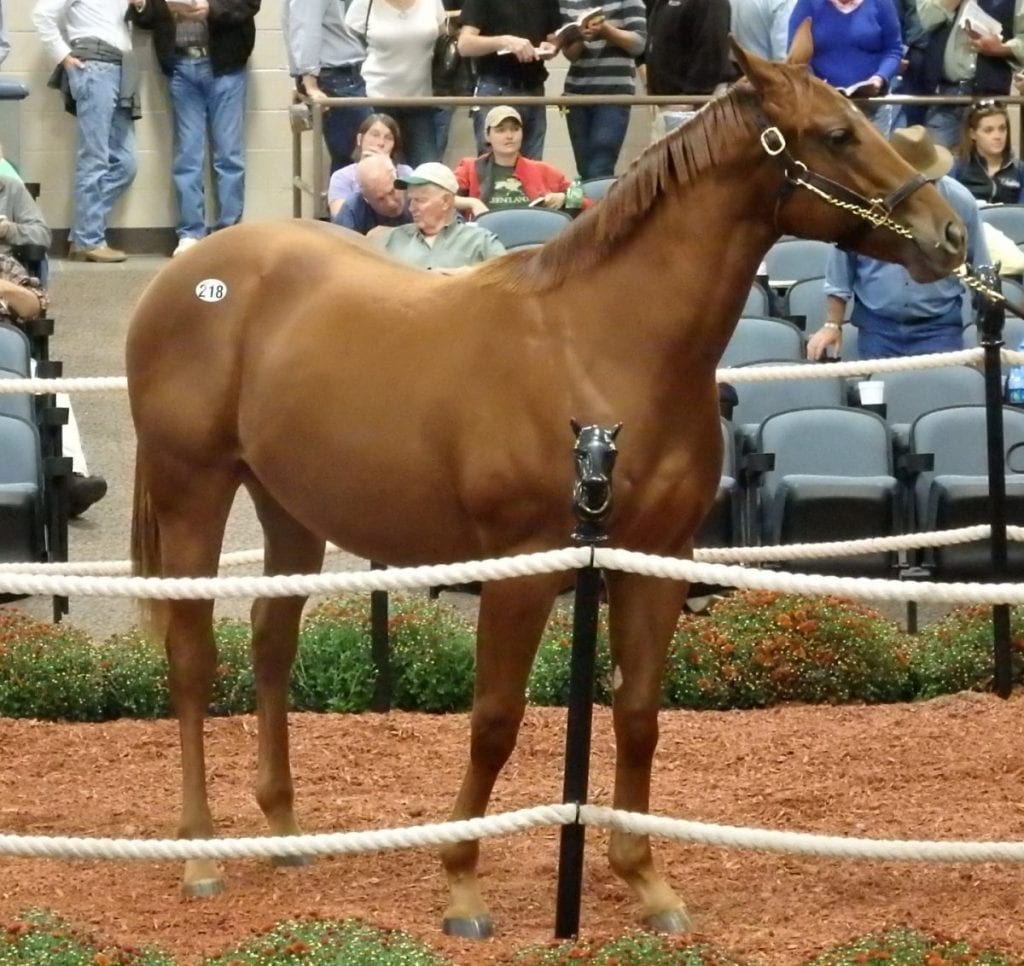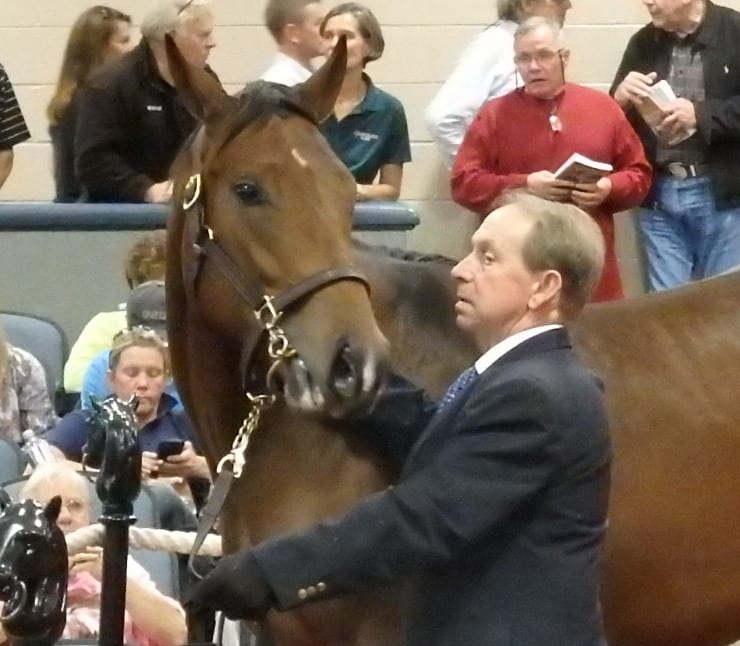
Hip 218 in the ring Tuesday at the Fasig-Tipton yearling sale. Photo by The Racing Biz.
by Frank Vespe
The good news was in somewhat short supply as day turned into night Tuesday in Timonium.
True, former Olympic skier Bode Miller weighed in on the day’s Fasig-Tipton Midlantic Fall Yearlings sale, purchasing a Not for Love colt for $140,000. And Samantha Siegel was on the grounds for the first time in several years, leaving with a trio of colts, by Not for Love, Jump Start, and Redeemed.
But all in all, the sale started slowly — hip number 1 was out, and the first to bring a significant winning bid was hip 50 — and while it picked up momentum later in the day, it never really achieved escape velocity.
By day’s end, gross and average sales were both off more than 10 percent from a year ago. And, though buybacks declined a bit, to 25.3 percent, that combination of factors made it the company’s least productive Midlantic yearling sale since it went to a one-day format in 2012.
A three-day sale as recently as 2008, the event slipped to two days, then to one. The number of hips sold has declined from 483 in ’08 to 274 this year. And the average sale price has fallen from a high of $25,847 in 2013 to just $19,083 this year.
All of which leads to a deceptively simple question: What’s going on here?
Theories abounded in the gloaming Tuesday.
One popular theory points the finger directly at Fasig-Tipton itself.
“I think Fasig-Tipton killed this sale by what they’ve done in Kentucky with the October sale,” said Larry Johnson. Johnson owns Street Magician, the promising young Maryland-based sire, six of whose progeny sold on Tuesday, one to Johnson himself.
“They used to have a lot of the big Kentucky consignors come up here,” he continued. “That gets enthusiasm. That gets buyers. Without buyers, you have a pretty bad sale, and there’s not a lot of buyers here.”
What Fasig-Tipton has done, Johnson and others pointed out, is expand its own October yearling sale in Kentucky. That is now a three-day event with nearly 1,500 hips cataloged. Couple that with Keeneland’s 12-day September sale, which ended on the 26th and saw 2,745 yearlings sold, and that makes the one-day Midlantic sale something of a forgotten middle child.
Dark Hollow Farm’s David Hayden, among others, agreed.
“I totally understand the economics for Fasig-Tipton,” Hayden said. “They have their own sales facility down there; it’s cheaper for them. But it’s really hurt this sale a lot with bringing in buyers. The more horses you have in a sale, the more buyers will show up.”
Yet while many agreed that the Midlantic sale now finds itself in a tough spot, a number of horsemen on the grounds said privately that they believed the quality of the horses on offer needed to improve, as well.
Hayden is one who subscribes to that theory. His and his wife JoAnn’s Dark Hollow Farm sold three horses for more than $70,000 each, including the sale’s top-selling colt, a $190,000 son of Bodemeister. But he said that he had seen a number of horses at the sale that looked as if they had only recently come in from the field.
“One thing I think people have to learn around here is you have to bring in a quality horse,” he said. “People do themselves a huge disservice by bringing in inferior product. It just doesn’t work.”
Johnson echoed that comment.
“I wish there was a way that the people in Maryland that breed commercial horses had more incentive to keep them here, and that goes for me too,” he said. “I take my better horses to Keeneland because I don’t want to subject myself to this.”
On the day 28 horses sold for less than $2,000, with another handful not meeting their reserves after drawing bids of less than that amount. That glut of bottom-level yearlings was more than enough to drag down the average even with five six-figure horses in the sale.

A yearling checks out the sale scene. Photo by The Racing Biz.
One of the issues in that regard, Hayden believes, is the paucity of commercially popular stallions in the mid-Atlantic. With the retirement of the great Not for Love and, before him, Two Punch, in recent years, there is something of a regional vacuum. Indeed, Jump Start, at Northview-PA, is the mid-Atlantic’s only sire standing for as much as $10,000; there are more than 100 such stallions in Kentucky.
“You look at the top quality 10 or 15 horses that sold, they were not by Maryland or regional sires,” Hayden pointed out. In fact, of the top 15 horses, only four were by regional sires, and two of those were by the now-retired Not for Love. Jump Start contributed an $85,000 colt, and Talent Search sired a $70,000 filly.
“We need more time for some of these Maryland sires to develop on the racetrack,” Hayden said. While young sires like Street Magician, the region’s leading second-crop sire; Friesan Fire, leading first crop sire; and Talent Search show promise, it remains unclear whether they or the region’s other sires will be able to fill the shoes of Not for Love and Two Punch.
Yet a third theory focuses on veterinarians and the effect of vets’ reports on would-be buyers. Vets are playing an increasingly important role in the sales arena, and some consignors believe that this has led buyers to be overly cautious.
“It’s harder now to hit the bullseye,” said Bill Reightler. “It’s very discriminating, and there’s the vet issues.
“You know, horses aren’t perfect,” he continued. His consignment, among the sale’s largest, brought in over $600,000, among them the $85,000 Jump Start colt. “They’re turned out in fields. They do whatever they’re going to do, and they get these little nicks and whatever. We’re in this era where in the vets’ reports, everything’s marked up on them, and it scares these potential buyers. There’s a very low tolerance for any flaw, and it’s made a difference in the sale.”
Cynthia McGinnes, of Thornmar Farm, mentioned those same sentiments prior to the sale, saying that in her mind, such an approach isn’t good for either horses or buyers. Thornmar had 10 hips through the ring Tuesday, all but one of which sold.
“If you want a horse with a completely clean x-ray, you have to hot-house it,” she said. “You can’t let it run around.”
Of course, the industry’s headwinds are well known, and chief among them are a shortage of owners, particularly those with the resources and patience to turn young horses into runners.
Bob Manfuso, of Chanceland Farm, pointed to that as a factor in a sale he described as “very spotty.” Chanceland bred and consigned the Not for Love colt that Bode Miller bought.
“I’ve been concerned for some time now that it’s tough, not so much on a horse like that [$140,000 Not for Love colt] — you’re going to get fair value on a horse like that,” he said. “The problem is horses for $10,000-$15,000, you don’t have a clue. People don’t want to put the development costs in them. I think racing’s got to look at that.”
It will often cost upwards of $25,000 to take a yearling from the sale to the racetrack. And though some horses from this sale will be racing by the middle of next year, others may take two years to get to the starting gate.
“There’s an awful lot of horses that are good, serviceable racehorses that nobody wants to buy,” added Johnson, the owner of Street Magician. “Then there’s people who are trying to figure out to bid $1,200 or $1,500. It’s like, are you kidding me? It’s going to cost you $25,000 to get to the races, and you’re pausing on $300? It’s insane.”
Still, not everyone took such a dim view of the proceedings. Some on the grounds said they were satisfied with the sale.
Phil Schoenthal, a trainer buying horses on behalf of D Hatman Thoroughbreds, was one of those. His clients went home with seven yearlings, ranging from $5,000 to $50,000.
“I feel like the free market is always right. What a horse is worth is what a horse is worth,” he said. “It’s a good sale because there are horses at every range and there are buyers for them. If you’re a breeder or consignor, you can bring any kind of horse here and know there’s going to be buyers for them.”
“I can’t complain about the sale,” added Reightler. “It’s the same old story: if you have the right kind of horse by the right kind of sire…”
At that moment, bidding on Hip 345, a Malibu Moon filly, reached $200,000.
“Case in point,” he concluded. “They waited around here all day for that.”









Very good article. I echo the comment that a lot of horses looked like they we wrangled out from the paddock (where they’d spent the last year) and pushed into the ring. Bleached, bitten, and unprepped. A;so a lot of bad horses by bad sires.
If you have a homebred, race it. Most buyers won’t buy your horse and you will lose money big time by running him/her through the ring.
Thanks, Horseman!
Racing in Maryland is still on a decline, at Laurel they have installed way to ma TV s for the bettors,
The quality of racing in the Maryland horse market is not a very Good quality. I think this will remain until some Group Buys the Laurel Race course from The Stornach Corp. I can’t see the industry getting better iin Maryland, I think the money , is In Horses for Polo, Eventing and Fox Hunting!! You have a little Gold mine , in Timonium Race Track, perhaps a 42 day summer meet, would help the price of Thoroughbreds in Maryland rise. Thanks for your time and Article. I didn’t understand a couple of weeks when Laurel had A $400 thousand and a $250 thousand grade purses,, that money would have done better spread out over the meet, Racing Fan for 64 Years.